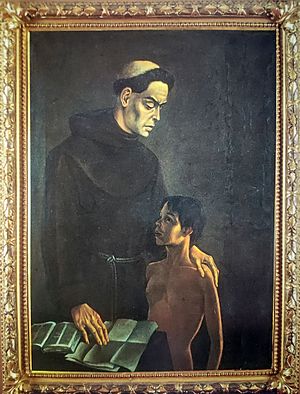Pedro de Aguado facts for kids
Friar Pedro de Aguado was a Spanish Franciscan friar who lived a long time ago. He spent about 15 years in a place called the New Kingdom of Granada, which is now part of Colombia. His main job was to teach and preach to the native people there. While he was in this new land, he gathered lots of information. He used this information to start writing a big history book called Recopilación historial. He finished this book when he returned to Spain, but it wasn't published until many years later, in the 1900s. Other historians used his writings, even though it wasn't officially printed for a long time.
Contents
Life of Friar Pedro de Aguado
We don't know the exact year Pedro de Aguado was born. Some historians think he was born in 1513, while others believe it was 1538.
Arriving in the New World
Pedro de Aguado arrived in the New World around 1560 or 1561. He landed in Cartagena, a city in what is now Colombia. Soon after arriving, he likely traveled to teach the Muisca people.
Working with the Muisca
By about 1564, he was working as a pastor for the Muisca people in a town called Cogua. He helped build two churches there. Cogua became the first native town in the New Kingdom of Granada where all the people became Christians. King Philip II of Spain recognized this important achievement by Friar Aguado.
Moving to Bogotá and Writing
In 1571, Friar de Aguado moved to Santafé de Bogotá, which is now Bogotá. He became a leader in the local Franciscan group there. In 1575, he was sent back to Spain. His mission was to answer questions about whether the monks in the New World were being greedy or unfair.
He stayed in Spain until 1583. During this time, he worked on his history book, Recopilación historial. He had started writing it in Bogotá during his free time. The first part of his book was about Santa Marta and the New Kingdom of Granada. He probably wrote this part while he was in Bogotá. The second part was about Venezuela and Cartagena, and he likely wrote this in Spain.
Challenges with Publishing
Friar de Aguado tried for many years to get his book published. However, he faced many problems. Rules about getting permission to print books changed, and his first permission became invalid. A second permission also had new rules, making it very difficult. He also had money problems. Because of these challenges, his book was not printed during his lifetime. He had planned a third part for his book, but he probably gave up because of all the difficulties.
Later Life and Legacy
The exact date of Pedro de Aguado's death is also uncertain. It could have been anywhere from 1589 to 1608.
Even though his book wasn't published, other writers used his work. For example, Friar Pedro Simón used parts of Aguado's manuscript. The original manuscript that Aguado left in Spain was found much later, in 1845, by a historian named Joaquín Acosta. Other historians used it, but the book was finally published in the 1900s. Part I, Historia de Santa Marta y Nuevo Reino de Granada, came out in 1906. Part II, Historia de Venezuela, was published in 1913.
Works
- Historia de Santa Marta y Nuevo Reino de Granada (1906) (Part I, Part II – 1916/17 edition by Jerónimo Bécker)
- Historia de Venezuela (1913) (Part I, Part II – 1918/19 edition by Jerónimo Bécker)
See also
 In Spanish: Pedro de Aguado para niños
In Spanish: Pedro de Aguado para niños


